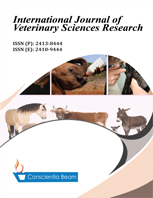Ectoparasitosis in Domesticated Turkeys (Meleagris Gallopavo) in Jere Area, Borno State, Nigeria
DOI:
https://doi.org/10.18488/journal.110.2019.51.11.22Abstract
The present cross sectional study was carried out to determine the prevalence and identify the species of ectoparasites infesting domestic turkeys (Meleagris gallopavo) in Jere area. The study was conducted from the month of April to October, 2016 of the study period. Out of the total of 300 domesticated turkeys examined for the presence or absence of ectoparasites, 185 (61.67%) were found to be infested with one or more ectoparasites. The prevalence rate according to the study locations varies as Galtimari Ward (15.0%), Mairi emirate (12.67%), Fori ward (12.33%), University Staff Quarters (11.0%) and Mairi Kuwait (10.67%) of Jere. Among the Four different types of ectoparasites encountered, Lice (31.67%) were found to be the most prevalent followed by the Flea (15.33%) and Mites (12.0%) while the Ticks (2.67%) are the least prevalent. However, among the eight (8) different species of ectoparasites found on the infested turkeys; the most prevalent species of ectoparasites found was Lipeurus tropicalis (17.67%), followed by Echidnophaga gallinacean (15.33%), Menacanthus stramineus (8.33%), Dermanyssus gallinae (7.0%), Chelopistes meleagridis (5.67%), Epidermoptes bilobatus (3.0%), Argas persicus (2.67%) and Cnemidocoptes mutans (2.0%) in a descending order of prevalence rate. There was mixed infestation with two or more species of ectoparasites in some infected turkeys. Ectoparasites infestation was found to be significantly higher in Adult (44.0%) than in the young (17.67%) turkeys (P = 0.0148; RR = 1.202). Ectoparasites infestation was also found to be higher in the female (33.0%) than in the male (28.67%) turkeys, but the difference was not statistically significant (P = 0.3102; RR = 0.9240). Ectoparasites infestation was found to be significantly higher in turkeys reared under the extensive (50.0%) compared to those reared under the intensive (11.67%) management systems (P < 0.0001; RR = 1.622). This is the first survey to determine the prevalence and identify the species of ectoparasites among domestic turkeys in Jere area of Borno State, Nigeria. The occurrence of ectoparasites in domestic turkeys indicated the existence of diverse ectoparasites fauna in the present study area which is associated with inadequate management system such as poor hygienic rearing system, poor husbandry and lack of strategic ectoparasites control practices.

